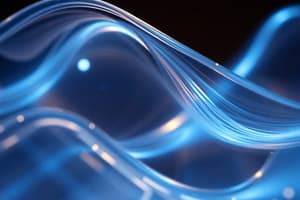Podcast
Questions and Answers
In Young's double-slit experiment, if the distance between the slits is doubled, what happens to the fringe width (assuming the distance to the screen and wavelength of light remain constant)?
In Young's double-slit experiment, if the distance between the slits is doubled, what happens to the fringe width (assuming the distance to the screen and wavelength of light remain constant)?
- The fringe width doubles.
- The fringe width quadruples.
- The fringe width is halved. (correct)
- The fringe width remains the same.
A thin film with an index of refraction of 1.42 is coated on a glass lens with an index of refraction of 1.60. For light with a wavelength of 560 nm, what is the minimum thickness of the film that will produce destructive interference for normally incident light?
A thin film with an index of refraction of 1.42 is coated on a glass lens with an index of refraction of 1.60. For light with a wavelength of 560 nm, what is the minimum thickness of the film that will produce destructive interference for normally incident light?
- 197.2 nm
- 295.8 nm
- 98.6 nm (correct)
- 394.4 nm
Light is incident from air ($n_1 = 1$) onto a piece of glass ($n_2 = 1.5$). What is Brewster's angle at which the reflected light will be completely polarized?
Light is incident from air ($n_1 = 1$) onto a piece of glass ($n_2 = 1.5$). What is Brewster's angle at which the reflected light will be completely polarized?
- 41.8°
- 67.2°
- 56.3° (correct)
- 33.7°
A light ray travels from water (n = 1.33) into air (n = 1.00). Above what incident angle will the light ray undergo total internal reflection?
A light ray travels from water (n = 1.33) into air (n = 1.00). Above what incident angle will the light ray undergo total internal reflection?
An object is placed 30 cm in front of a converging lens with a focal length of 10 cm. What is the image distance?
An object is placed 30 cm in front of a converging lens with a focal length of 10 cm. What is the image distance?
Which of the following phenomena provides the strongest evidence for the wave nature of light?
Which of the following phenomena provides the strongest evidence for the wave nature of light?
A single-slit diffraction pattern is formed on a screen. If the width of the slit is decreased, what happens to the width of the central maximum?
A single-slit diffraction pattern is formed on a screen. If the width of the slit is decreased, what happens to the width of the central maximum?
In a diffraction grating, what happens to the angle of diffraction for a given order ($m$) if the wavelength of the incident light is increased?
In a diffraction grating, what happens to the angle of diffraction for a given order ($m$) if the wavelength of the incident light is increased?
Which of the following phenomena can occur only when light travels from a medium with a higher refractive index to a medium with a lower refractive index?
Which of the following phenomena can occur only when light travels from a medium with a higher refractive index to a medium with a lower refractive index?
An object is placed 20 cm from a concave mirror that has a focal length of 30 cm. What is the nature of the image formed?
An object is placed 20 cm from a concave mirror that has a focal length of 30 cm. What is the nature of the image formed?
Flashcards
Wave Optics
Wave Optics
Studies light as a wave, explaining interference, diffraction, and polarization.
Huygens' Principle
Huygens' Principle
Each point on a wavefront acts as a source of secondary spherical wavelets.
Interference
Interference
Overlapping of two or more waves in space, leading to constructive or destructive effects.
Young's Double-Slit Experiment
Young's Double-Slit Experiment
Signup and view all the flashcards
Diffraction
Diffraction
Signup and view all the flashcards
Polarization
Polarization
Signup and view all the flashcards
Ray Optics
Ray Optics
Signup and view all the flashcards
Reflection
Reflection
Signup and view all the flashcards
Refraction
Refraction
Signup and view all the flashcards
Total Internal Reflection
Total Internal Reflection
Signup and view all the flashcards
Study Notes
There are no updates to the study notes, the provided text contains the same information already in the existing notes.
Studying That Suits You
Use AI to generate personalized quizzes and flashcards to suit your learning preferences.




